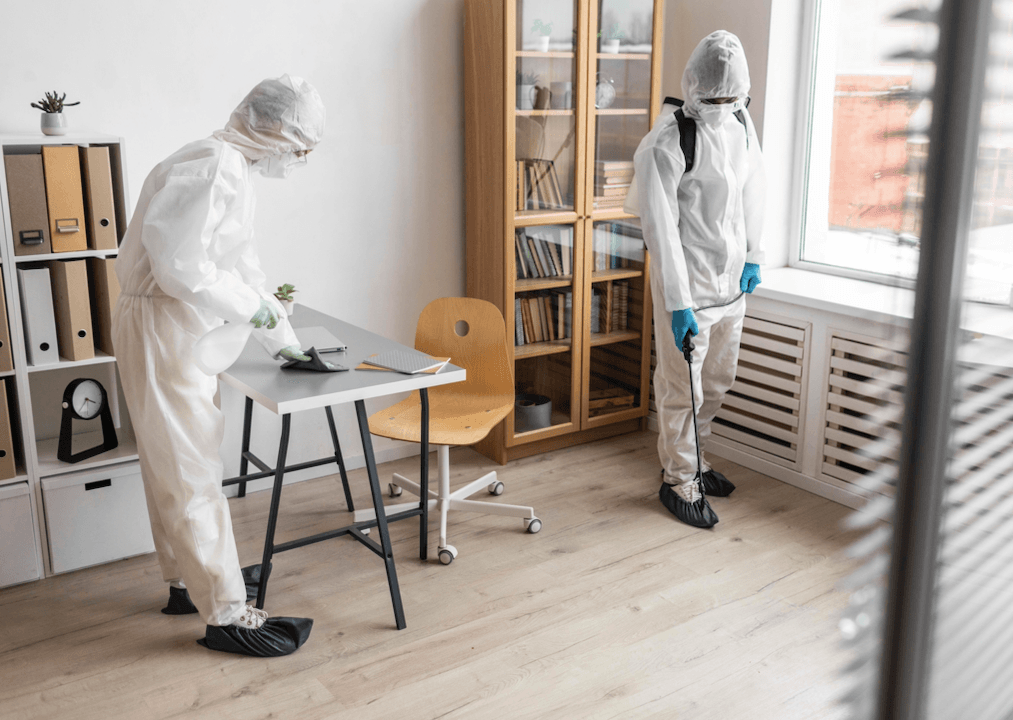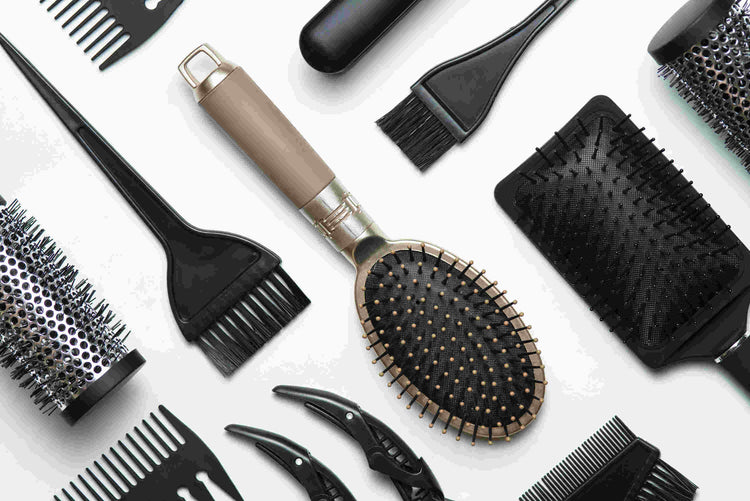Mold Allergy: Definition, Symptoms, Causes, Diagnosis, and Treatments


Mold is a fungus that often thrives in dark, damp environments. It's commonly found inside homes and businesses due to humidity or condensation and causes serious health issues for those prone to allergies. Mold allergy is an overreaction by the body's immune system when exposed to certain mold spores, resulting in cold-like symptoms such as sneezing; itchy eyes, nose, throat, skin; coughing; fatigue; watery eyes; congestion, etc.
Extensive exposure (or more severe allergic reactions) sometimes leads to additional conditions like asthma attacks with wheezing and difficulty breathing normally. People living in areas affected by floods are particularly vulnerable because sudden flooding increases the risk of the growth of molds indoors.
Symptoms associated with mold allergies typically include runny/stuffy noses; coughing; irritation/redness around the eyes; headaches; sore throats & chest discomfort, but these overlap with other respiratory illnesses caused by either bacterial or viral infections, so checking a doctor for accurate diagnosis is important. Other symptoms caused by black mold exposure include asthma-like attacks and swimming or irritated eyes. Hayfever sufferers often experience similar symptoms, and those sensitive to both pollen and mold may notice an intensification of their allergic responses during damp, warmer seasons.
Mold allergies are caused due to both indoor and outdoor sources of molds, so it's best to avoid things like open compost piles, standing water (in flower pots), damp basements, leaky pipes, etc., which all foster fungus growth. It's estimated that 15%–25% of Americans have some degree of sensitivity ranging from mild reactions to moderate to severe, but this further increases if left untreated, which leads to other conditions, including sinus infections. Diagnosis of mold allergy is made using a combination of skin and blood tests administered by an expert doctor based on the patient's history and a medical exam. As far as treatment options, starting from natural remedies (such as avoiding triggers, air purifiers, probiotics, etc.) to conventional medications prescribed, such as antihistamines like Benadryl or non-drowsy options like Clarityn, all help relieve symptoms.
Lastly, keeping up with regular cleaning schedules & checking for any water damage inside the home might prevent the development of new allergies caused due to the growth of different types of mold.
A Mold allergy is an immune system response to allergens produced by certain types of mold. It occurs when the body's allergic cells detect airborne particles from molds and trigger symptoms such as sneezing; itchy eyes/nose/throat/skin; coughing; fatigue; watery eyes; congestion etc. Allergy experts believe that more than 7 million people in North America are affected by different kinds of allergies due to inhaling fungal spores at home or workplace, with some even experiencing asthma-like attacks.
The primary cause behind mold allergies is exposure to tiny plant seeds known as "spores," which readily get suspended in the air & are difficult to avoid entirely. When breathed indoors, they often accumulate, creating an ideal environment for the growth of colonies, eventually causing an intense inflammatory response capable of leading to numerous health issues like itchiness, throat irritation, etc. (especially among those predisposed genetically). Furthermore, prolonged exposure to black molds has been reported to further worsen existing nasal allergy disease reactions, proving a strong link between indoor environmental pollution & human respiratory concerns. In conclusion, the exact definition of mold allergy is an allergic response to airborne fungal fragments which cause severe symptoms (if left untreated), eventually leading to other health issues.
Mold allergies are also referred to as Fungal allergies meaning that any allergic reaction to fungi, which includes molds, is referred to as a fungal allergy and causes symptoms of a mixture of respiratory & skin irritation.
Fungi are present in almost every environment on earth; therefore, human exposure to them is quite common, in most cases, harmless, so few previously healthy people might develop allergies. Allergic reactions are caused when antigens from these organisms interact with IgE antibodies body's immune system resulting in histamine release. As a result, patients experience a runny nose, eye itching, dry cough, wheezing or vomiting, etc. Fungal allergens differ from seasonal hay fever because they occur year-round, not necessarily dependent upon the time of year, since indoor spores float around, causing problems even in summer. Therefore it's important to recognize potential exposures and immediately act to prevent further complications.
Mold allergy occurs in any part of the body; however, it is most commonly seen in respiratory organs like nasal passages and airways. When a person inhales mold spores, these particles trigger an allergic reaction leading to symptoms such as sneezing; itchy eyes/nose/throat/skin; coughing; fatigue; watery eyes, etc. In some cases, allergies caused due black molds to cause dizziness, headaches, or more severe asthma-like attacks.
Symptoms are usually worse when staying indoors since all indoor activities (such as cooking) produce moisture which encourages the growth of colonies, so it's important to identify potential sources & use solutions suggested by doctors to prevent further reactions. Due to exposure to damaging spores, humans face direct consequences on their health and might experience difficulty breathing, throat inflammation, or other effects resulting from weakened immune systems. Therefore understanding how this condition occurs makes informed decisions regarding prevention treatment options available to handle unwanted effects developing complications associated with Extended exposure to black molds even riskier causing heart palpitations.
Mold allergy differs from other types of allergies because it is caused by exposure to fungi spores rather than responses triggered by proteins or histamines in pollen and certain foods. While symptoms related to mold allergies are sometimes similar to those associated with seasonal hay fever (such as sneezing, runny nose, red eyes, etc.), they tend to persist for longer periods. The primary difference between the two is how an individual reacts when coming into contact with a particular allergen. For example, people who suffer from seasonal rhinitis usually experience irritation only during a specific season, whereas individuals susceptible to mold likely experience persistent problems over a long period, even after avoiding triggering particles. On the other hand, food allergic reactions often immediately feature severe cases leading to anaphylaxis. In conclusion, while many similarities exist between different kinds of allergies, differences lie mainly in the source & type of reaction experienced once exposed to the same allergens. Interestingly enough, responses vary slightly depending on the diagnosis.
There are multiple common symptoms seen in mold allergy. The symptoms are mostly not severe, but on rare occasions, individuals with extremely sensitive fungi exhibit more severe complications such as anaphylaxis. The same applies to multiple mycotoxins indoors capable of inducing similar effects, so it is important to recognize potential exposures and take necessary steps to prevent further health issues.
Below are the common symptoms of mold allergy:
Many people with mold allergies experience skin rashes due to the allergen's presence. These vary in severity, ranging from small bumps or hives lasting less than 24 hours to painful and long-lasting blisters.
Skin rashes are often caused by irritation from exposure to certain allergens, such as molds which release tiny spores into the air when disturbed. These microscopic particles are inhaled or come into contact directly with exposed skin causing itchy red spots known as hives; these spread across large areas, making them difficult to treat without proper medical attention for underlying causes like allergies that need specific treatment regimens. To help ease irritation and discomfort, products like E45 Itch Relief Cream can be applied directly to affected areas to reduce inflammation and soothe the skin.
Headaches are a common symptom of exposure to mold allergens, ranging in intensity from mild pressure around the head area to severe throbbing pain lasting several days. Headaches caused by mold allergy sometimes worsen when entering an environment with high fungus levels.
Headaches occur due to sensitivity towards certain allergens like molds releasing their spores into indoor environments; this triggers inflammation in upper respiratory tracts leading to cervical pain and producing tension-type headaches at the base neck area if not addressed adequately through medications prescribed by specialists dealing specifically with allergies-related issues like immunologists ideally suited for diagnosing severity levels so treatments targeted precisely right track towards quickly achieving resolution.
People who suffer from exposure to certain fungi typically feel tired most of the time, even after adequate rest. Being constantly tired is one sure way the body signals it's struggling against physical toxins like molds and needs help breaking this cycle.
Fatigue is often seen as a symptom of mold allergy; when the body is exposed to allergens for extended periods, it sometimes leads to fatigue due to increased immune response and inflammation in affected areas which require greater energy reserves for the healing process that eventually get depleted leaving person feeling mentally and physically worn out long after the exposure occurred or has already ended. Still, the system hasn't yet recovered from the previous reaction caused by the allergen presence. If this happens consistently over time, then specialized medical diagnosis becomes important. Hence, proper treatments start helping the individual regain normal levels again without recurring episodes constantly occurring throughout the day to ensure a better quality of life through the whole ordeal until complete relief finally manifests through a successful conclusion at the end-line goal completion point, where normality returns once more.
When inhaled, spores trigger an allergic reaction within our bodies airways constrict, leading us down a path towards asthma attacks and other respiratory conditions, including wheezing – either a whistling sound emanating during exhalation or inhalation - produced much more audibly than regular breathing sounds usually heard while resting quietly on the bed at night.
Wheezing is a common symptom of mold allergy and typically indicates an inflammatory response within airways leading up into the lungs upon inhalation mold's spores are released indoors or outdoors depending on where the allergen source is located. If present near a location outside the home environment, those living inside only react till a certain distance away before no longer registering any reactions since the worst effects tend to occur closer to the proximity site beyond.
Inhaling particles released by mold irritates the throat. It causes difficulty in breathing due to constriction of air passages inside the chest cavity resulting in a wheezing sound people make while attempting to breathe normally but find this impossible task just because inflamed state inflammation allergy symptoms persist without abatement controlled through effective treatment plans tailored specifically fit sufferer's needs best-fitted suit overall condition even if means having different types medications taken concurrently address all major issues at once thus creating chance complete resolution sooner than later depending how long ago initial exposure occurred.
Those affected by a fungus allergy often experience chest tightness due to allergen particles inside their lungs. The reaction leads to constriction in breathing, making it harder for fresh air to enter the deep parts of the respiratory system – particularly visible during inhaling and exhaling processes when much-needed oxygen gets blocked from entering necessary areas where it starts its healing process. To support respiratory relief, especially when dealing with mucus or congestion, products like Potter’s Chesty Cough Syrup may help loosen chest phlegm and ease breathing discomfort.
A sneeze is usually an early indication of exposure to something the body is extremely sensitive to, like molds or fungi. The reflexive action protects against bacteria, pollen, or any other material that irritates if entered through the inhalation route.
Sneezing is caused by irritation to sensitive nasal passageways leading up to sinus cavities that become inflamed. Upon entering contact with mold allergens present nearby the environment where a person lives or spends much time when venturing outdoors, areas have higher concentrations of airborne spores being indefinitely suspended near ground level increases the likelihood of triggering a sneeze reflex quickly followed series of others 2eventually leading full-blown attack replete runny, stuffy noses watery eyes vehemently itching which means seeking immediate medical attention ensure proper therapeutic interventions put place deal swiftly symptoms don't worsen disproportionate proportion already faced suffer insurmountable degree severity exacerbate whole situation any further making matters worse instead better expected further treating condition more efficiently than ever before.
When detectable amounts of mold spores get into the sinuses, sudden inflammation occurs, potentially leading to intense physical discomfort and unpleasant feeling associated with pressure build-up around the particular side(s) on the face causing significant facial discomfort, sometimes lasting multiple days without proper treatment.
Sinus pressure or congestion occurs when inflammation in the sinuses caused by inhaling allergenic spores triggers excessive mucus production, leading to obstruction and increased airway resistance. The resistance results in pain around the eyes, cheeks, and forehead, as well as difficulty breathing through the nose or mouth due to excessive nasal secretions blocking off entrances into the lower parts body where oxygen needs to travel to reach cells. Vital organ functions require optimal functioning and keep going strong throughout day-long periods. Activity stressors arise during daily routines, and work-life balance endeavors attempt to maintain sanity brains.
Nobody likes watery eyes, especially while reading books or magazines - continuous tears have a tendency to block up important view spots reducing task effectiveness, moisture build-up causing itching, eyelid swelling (Xanthelasma), along red veins appearing across the white part near the iris as well.
Watery and itchy eyes are often symptomatic of mold allergy; exposure to allergens causes these symptoms when particles come into contact through either inhalation or direct skin contact, depending on the situation. As the exposure continues, the issue may progressively worsen, leading to more severe symptoms such as swollen redness, runny noses, and nasal discharge. To alleviate eye irritation, products like Hylo-Forte Lubricating Eye Drops and Murine Irritation & Redness Relief Eye Drops can provide relief from dryness, redness, and swelling.
Mold allergy sufferers often experience increased sensitivity to dust, pollen, and other environmental particles, which triggers a runny nose. These symptoms usually escalate if untreated, causing nasal congestion and making breathing hard for persons affected.
Runny or stuffy noses are common symptoms experienced by individuals suffering from mold allergies. The mucous membranes lining the nasal passages become inflamed and irritated when exposed to allergens, resulting in an increased production of secretions and congestion, making it difficult for air to flow freely through the nose. The congestion often leads to a runny or stuffy nose accompanied by sneezing and coughing as well as watery eyes due to further irritation caused by constant sniffling when trying clear blocked sinuses up again, only to face another episode next few minutes later - thus presenting a never-ending cycle must break out eventually if not taken seriously since start so proper medications prescribed time lead successful resolution without any exacerbations even occurring once.
Coughing is a common symptom of fungus-related allergic reactions as our bodies try to purge themselves from the external irritants outside the environment or lingering inside the respiratory system. Severe coughing fits originate multiple times during a short period of time, leading to chest tightness, headaches, wheezing, and even lung infections in some cases.
Coughing is a symptom associated with sensitivity towards molds releasing their spores into indoor environments; this triggers inflammation in lower respiratory tracts leading up throat areas producing dry, flaky cough reflexes at the base chest area if not addressed adequately through over-the-counter regimens like antihistamine pills typically used treat seasonal allergic reactions but sometimes need to talk doctor specialist knowledgeable about treating specific type allergen found case crisis requiring more specialized medication regimen that fit lifestyle accordingly ensuring optimal healing further making sure complete resolution now becomes achievable goal once more.
Mold allergy symptoms manifest anywhere from a few minutes to several hours (or longer) after exposure. The severity and types of allergic responses vary from person to person depending on how sensitive they are towards particular allergens present in the environment. Generally speaking, respiratory reactions such as sneezing or running nose appear soon after contact with spores. At the same time, other systemic signs take some time before developing fully, e.g., skin rash showing its effects typically takes more than 6 hrs to post inhalation of allergenic particles for sufferers. It's important to know that an individual is susceptible to mold allergies; it is best practice to exercise precautionary measures when traveling in areas with high spore concentrations to minimize these unwanted repercussions. Lifesystems Expedition Midge Repellent DEET Free Spray and Lifesystems Expedition M can be useful tools in preventing bites and skin reactions when spending time outdoors in mold-prone areas.
Difficulty concentrating is a common symptom of mold allergy due to inflammation in the upper respiratory tract, which is irritating when exposed to airborne allergens. The inflammation lead to an increased production of mucous and congestion which block off oxygen from essential areas like brain, resulting in cognitive impairments such as difficulty focusing on tasks or thoughts for prolonged periods as well having difficultly staying alert despite attempting do so - leading decreased productivity overall day with lack energy motivation required complete tasks time set forth without proper sleep being had beforehand. The mind still has enough attempt struggles focus objects intently half hour before starts fogging up again due constant irritations afflicted upon body long-term exposure takes place initially affecting one's ability concentrate intensively irrespective setting whether home work office school etcetera.
It is important to make sure allergen source gets identified quickly acted upon sooner rather later lessen effects produced by inflamed infected state parts corresponding regions affected compromised heavily if left unchecked eradicated just soon enough attention given sector then full recovery need to follow suit thereafter while taking appropriate medications prescribed specialists dealing specifically allergies related issues immunologists ideally suited diagnosing severity levels so treatments targeted precisely go right track towards achieving resolution optimally within predetermined period narrowed down wherever feasible depending individual's specific sensitivity level around area avoidance methods implemented instantly begin further minimizing risks associated living near any known molds' release confined space indoors or outdoors depending where allergen source located nearby if present close proximity-wise situation at hand dictates which avenue takes place first then subsequently builds up slowly but surely eventually becoming full blown issue one must address.
Yes, experiencing depression or anxiety is sometimes seen in mold allergy. It is because exposure to allergens such as molds produce inflammation in the body that affects certain areas like the brain and central nervous system (CNS), leading up decreased mood levels – along with increased stressor which contributes towards the onset of both mental states mentioned earlier being noted although they not directly caused by allergen contact source itself but rather secondary effects resulting indirectly through additional malfunctions occurring within organ systems affected due prolonged irritation taking place without proper treatment interventions been put forth order assuage negative impacts brought upon individual concerned during course process wherein s/he suffers extreme forms fatigue until exhaustion mentally steps taken to restore balance eventually prevent worsening results seen ominously escalating proportionately every single day it goes unchecked ignored.
Scientifically speaking though no direct cause-and-effect relationship exists between allergies suffer emotional distress; however, once trigger symptoms start manifesting themselves further then situation gets complicated demands far more serious attention involves medical diagnosis immediately followed treatments tailored specifically fit sufferer's needs best suited suit overall condition even if means having different types medications taken concurrently address major issues at once thus creating chance complete resolution sooner than later depending long ago initial exposure occurred begin highly recommend getting checked out visit doctor specialist knowledgeable field ensure underlying causes get addressed adequately otherwise constant worsen exponentially over period time long-term resulting severe consequences prove nearly impossible overcome eventually lead total destruction entire system need rebuild ground zero which never desirable outcome wished anyone – peace health joy today tomorrow every day hereafter until eternity divine grace shines upon us blesses lives into abundance unimaginable living happily ever after without any recurrences whatsoever.
Yes, all types of mold cause mold allergy symptoms. However, the most common type of mold that causes these reactions is Cladosporium which is a genus of fungi with over 30 known species found worldwide in outdoor and indoor environments alike - such as decaying plant material contaminated soil walls where humidity high enough supports growth spores they release into the air when disturbed life-cycle takes place leading eventual spread reach even further distances away depending upon wind currents weather patterns location geographically placed otherwise.
The particular allergen responsible for causing the majority of allergic reactions manifests person sensitive to it either having an existing predisposed condition before coming to contact with any or developing swiftly after exposure took place already, then flare-ups start resulting in the direct result presence of molds of inside the home environment be addressed promptly through identifying the source eliminating whatever factor making conducive propagating further along way beyond merely dealing immediate repercussions faced front line quickly diminishing seen just soon measures implemented applicable going get back normalcy state before the whole episode began order to regain optimal levels health again without suffering recurrences whatsoever.
The symptoms of mold allergy in adults and children differ due to differences in their immune systems. The most common symptom in adults is a skin rash caused by exposure to allergenic spores released into the air when disturbed. The irritation often leads to wheezing and chest tightness as well as sneezing, sinus pressure, or congestion in nasal passages leading up runny/stuffy nose accompanied by itchy, watery eyes followed suit by coughing fits before finally ending exhaustion levels felt afterward having gone through an ordeal befitting description one attribute such maladies. But fortunately, kids typically tend to suffer less intensely since the body starts building an immunity system against allergens like molds releasing airborne particles further away from the site, thus decreasing the chances of flare-ups occurring more frequently than expected. Adults perpetually surrounded by an environment conducive to propagating unchecked unmitigated growth rates propels ever onwards truly limited only natural restrictions encountered wherever manageable.
However if steps taken properly recognize identify source material causing reaction then measures put place begin diminish severity effects seen gradually over time until complete resolution achieved resulting optimal health regained without any lasting repercussions still persisting beyond threshold set forth beforehand which good outcome overall considering circumstances lead here eventually anyway so talk to a doctor specialist in a knowledgeable field to ensure underlying causes and get addressed adequately otherwise constant worsen exponentially given length stayed exposed matter further addressed soon with proper treatments suited individual's specific sensitivity levels area avoidance methods implemented instantly begin assuage negative impacts brought upon person concerned during course process wherein s/he faces extreme forms fatigue until exhaustion sets all again bringing full circle entire ordeal finally reaching end-line goal completion point where normality returns once more.
Mold allergy is a common condition caused by sensitivity to mold spores in the air. When exposed to certain molds, people with this type of allergy experience runny noses, sneezing, itchy eyes, and other respiratory symptoms. The severity of these reactions ranges from mild discomfort to life-threatening anaphylaxis, depending on the person's level of sensitization and exposure. When looking at potential causes for developing a mold allergy, several environmental factors increase one's risk:
Mold reproduces through microscopic particles released into the environment known as spores – these are found indoors and outside in areas where humidity is high or moisture accumulates, such as gardens and pond banks. Long-term inhalation or contact with these airborne spores causes them to build up in our bodies, making us sensitized (i.e., allergic). Examples include working outdoors around plants/soil; living near water sources; being frequently exposed during regular household cleaning like dust sweeping/mopping; going camping etc. Indoor environments which lack ventilation or become damp easily create perfect conditions for spore formation enabling further allergen build-up over time, even without us realizing it.
Homes that experience flooding, plumbing issues, or other water-related damage become breeding grounds for mold growth. Structural materials such as wood floors/walls/ceilings absorb moisture very quickly and start forming colonies of fungus (visible on surfaces) – these release allergenic particles into the air, inhaled without knowing their presence. The same goes if there's an undetected leak in an individual's home – upon discovery, it's important to take action immediately before major contamination occurs.
Basements tend to be especially vulnerable due to accumulating moisture without proper ventilation; having carpets around encourages further formation over time, so ensure they're cleaned regularly. Clothes closets need attention since clothes provide organic matter for fungi growth when dampness accumulates inside them - try keeping everything organized with cedar chips scattered throughout shelves too. And don't forget about laundry; washing items at a low temperature helps prevent allergens from sticking onto fabrics; using hypoallergenic laundry detergents is another good measure.
Certain items are prone to collecting spores, including food, paper products (e.g., books/newspapers), clothing and bedding, etc. Always check for signs of mold before purchasing items like these; doing a smell test to ensure it doesn't give off an unpleasant odour is advisable as well. Avoid contact with surfaces that frequently accumulate dust, such as carpets and curtains - as they are breeding grounds too, so vacuum them regularly using HEPA filtration systems or replace them with hardwood flooring.
Pollen season is when levels of airborne allergens peak due to increased activity by plants during certain times each year; this applies to molds which tend towards higher concentrations in spring/fall depending on the living area. Ensure the window screens are kept clean and closed when there's lots of pollen circulating outdoors – the same goes for car windows, too, if planning on driving somewhere nearby. Taking antihistamines before heading out provides further protection against inhaling spores from the environment.
Certain occupations expose individuals to higher levels of mold, resulting in the development of an allergy. These include workers who experience exposure regularly and those in professions where avoiding damp or humid environments is not attainable:
1) Agriculture Workers/Farmers: People working outdoors with plants and soil often come into contact with spores from fungi living naturally within this environment – these particles become airborne when disturbed during tilling, harvesting, etc., making it easy for them to inhale without realizing until symptoms start showing up. Taking breaks at least once every hour helps reduce prolonged inhalation; long-sleeved clothes must be worn while out working to avoid mixing bodily fluids (e.g., sweat) too easily, leading to further contamination.
2) Construction Employees: Buildings under renovation suffer from water damage/leaks frequently due to excessive moisture accumulation over time, reducing air quality significantly; thus, workers must wear protective equipment such as masks when entering these spaces; otherwise, they risk getting exposed more quickly. In addition, contractors dealing directly with hazardous materials like asbestos require special care since even small amounts cause health issues down the road if left unmonitored.
3) Cleaning Personnel: Professionals daily cleaning dirty surfaces risk their bodies when handling molds growing indoors; thus, they must wear specific protective gear while in use – these range from full-face respirators to gloves/goggles depending on the severity of the situation. Ensure employees understand their roles' importance, ensuring their safety and other workers around them (i.e., family members living in the same house, etc.).
4) Healthcare Professionals: Those working within hospitals need to exercise caution even if spores aren't visible, as allergens are seen to be lurking inside air ducts or furniture surfaces. In addition, special attention needs to be paid to anyone undergoing mold inspections due to its potentially hazardous nature during certain procedures, so make sure the training provided thoroughly covers all aspects and applicable precautions taken every time.
In sum, it's important for those susceptible to developing a mold allergy to recognize potential occupational risks before taking up any job that puts them at high levels of exposure – discussing with employers about preventive measures helps ensure a safe environment for both parties involved.
Yes, mold exposure in childhood causes mold allergy later in life. Allergies are caused by the body's immune system responding to an environmental allergen (in this case, a type of fungus) that it perceives as harmful and triggering antibodies to combat them. Being exposed at an early age sensitizes the body enough so that these reactions become more severe than usual when coming into contact with similar strains down the line – either through inhalation or physical contact.
The mechanisms behind how this happens remain largely unknown, but scientific research suggests genes have some influence over development; for example, those with family histories involving asthma seem particularly vulnerable during formative years, so caution needs to always be taken before letting young children around areas likely containing high concentrations of spores like damp/humid places, etc. Additionally, proper ventilation indoors greatly reduces chances, too, since spores tend to settle onto surfaces if left unchecked.
Mold allergy has been linked to asthma, primarily through the triggering of inflammation in the airways. Asthma involves constriction and swelling of the bronchial tubes due to irritation by allergens or other triggers; this is often paired with difficulty breathing/coughing and increased mucus production, further complicating symptoms even more. In cases involving sensitization towards molds, exposure causes an immediate reaction within minutes (vs. hours like pollen) – making it hard for those affected to differentiate between them, leading to potentially life-threatening situations if left untreated.
Asthma occurs because when inhaling spores, they become lodged inside our bodies, sparking a response from immune cells seeking out foreign invaders known as 'allergens' and causing the release of histamine into the bloodstream, thus narrowing respiratory passages while increasing mucus production. Furthermore, research suggests certain mycotoxins produced by fungi sometimes worsen existing lung conditions too. However, the exact mechanism remains unclear, so further studies are needed before definitive conclusions are drawn regarding the link between mold allergies & asthma.
Molds allergies are diagnosed through various methods, including skin prick tests, blood tests, or even symptom assessments by a qualified medical professional. With the former two options, patients are exposed to different types of mold extracts (either topically on the forearm or injected into the bloodstream) to observe how their body responds – if a positive result is detected, this usually indicates sensitization toward that allergen. On the other hand, allergy specialists use physical exams & personal history taking when evaluating the severity of any reactions being experienced to better pinpoint the source problems without relying solely on laboratory results.
In addition, self-monitoring behaviours like keeping track of daily activities/symptoms over time help provide further insight regarding triggers behind allergic episodes; e.g., running nose after working in the garden means there are high levels of spores present in the environment, which require avoiding - same goes for going camping, etc. Self-monitoring behaviours might not yield definitive answers, but it is a great starting point.
Diagnostic tests to confirm a mold allergy typically involve either skin prick or blood testing. Skin prick testing involves exposing the patient's forearm to an allergen extract, usually made from various types of fungi, for any potential reaction to be monitored closely; this test helps identify sensitization towards molds quickly without requiring a large sample size. For blood testing (serology as well), samples taken are analysed further by laboratory technicians detecting antibodies present within them, which provides more accurate results than other methods due to their specificity.
Some doctors prefer using nasal/spoon swabbing instead. These devices pick up particulate matter sampled directly through airways, allowing specialists to evaluate if excessive spores are being inhaled in real-time. However, take longer to get results back compared to other techniques mentioned above, particularly when having to perform multiple tests over the near future, so keep that in mind during the consultation process too.
The length of a diagnostic test for mold allergy typically ranges between 15-30 minutes, which is the amount of time necessary to evaluate a patient's skin response when exposed to extract (for either a prick or blood tests), as well as any reactions experienced during the evaluation period. For nasal/spoon swabbing, these samples taken from airways are often analysed further. Hence, laboratory technicians obtain more precise readings, which take up to a few extra hours depending on the type of analysis being performed. Therefore the overall process usually doesn't last longer than an hour maximum unless multiple screening sessions are required over the near future (e.g., if the first one failed, detect sensitization, etc.).
No, mold allergy diagnosis cannot be done at home. Diagnostic tests require specialized equipment and expertise to evaluate the results correctly - this is only available through certified medical professionals or facilities with proper licenses. Self-testing is dangerous as it involves exposing oneself directly to potential allergens without any supervision, thus increasing the chances of anaphylactic shock (severe allergic reaction) if real sensitization exists.
The best thing for anyone experiencing allergy symptoms is to visit their primary care physician to discuss the causes; if suspicion exists regarding molds being the culprit, then the specialist recommends further testing, such as skin/blood analysis beforehand, confirming diagnosis properly before proceeding to the next steps.
The following are treatments used for mold allergies:
This oral medication is used to treat asthma and allergic rhinitis – it works by blocking the action of a certain chemical in our bodies known as leukotriene, which plays a role in inflammation/allergy reactions. Its effectiveness depends on the severity of symptoms; when prescribed, the doctor's instructions must be followed closely for optimal results. Side effects include rash, dizziness, headaches, and abdominal pain, which are generally mild.
Immunotherapy is a common medical treatment for allergies that works by introducing small doses of allergens into the body over time with the hope that, eventually, the immune system becomes desensitised to them. The treatment involves injecting substances such as pollen or mold extracts beneath the skin regularly until one builds up tolerance levels against those allergens causing allergic reactions. The effectiveness of this therapy varies from patient to patient, depending on their body's response. Still, generally, immunotherapies have been proven quite successful at alleviating symptoms associated with many types of allergies, including mold allergy, when under strict supervision by qualified health professionals such as dermatologists or allergists who provide these treatments. Generally speaking, immunotherapy carries minimal side effects; however, redness and swelling sometimes develop when injections are administered due to temporary inflammation caused by allergen exposure, which dissipates soon after treatment.
Allergy shots are a type of treatment for allergies that is administered by injecting small amounts of allergens into the body over time. Allergy shots work on reducing sensitivity to an allergen and increase tolerance levels against it with the hope of eventually alleviating symptoms associated with its presence. The effectiveness level for allergy injections depends largely on the severity of one's allergic reaction before starting this treatment. Still, in many cases, they have successfully provided relief from typical signs caused by mold exposure, such as sneezing, runny nose, and nasal congestion. Allergists generally recommend getting these treatments done at least once every two weeks, which leads up to three years, depending upon each patient's response rate towards injections. However, most find their best course after roughly 24-36 months. Side effects experienced while undergoing allergy shots include redness, swelling, and itching around the injection area due to temporary inflammation developed post-administration; however, it usually dissipates within a few minutes following the session ends.
Histamine is one main substance involved in reacting to allergens, so trying to block its formation helps reduce suffering; antihistaminic drugs like Zyrtec do exactly that while addressing other underlying factors, too (e.g., nasal congestion). Generally considered safe to take with few potential side effects being dry mouth/eyes and nausea, doctor's instructions for proper dosages must be followed to prevent slipping into drowsiness too.
Drugs used open up airways in case wheezing occurs caused by exposure to certain allergens – these are typically taken through inhalers but are prescribed orally as well, depending on severity. Common examples are albuterol (inhalation form) and salmeterol xinafoate (oral tablet). Side effects include rapid heart rate, chest tightness, and dizziness, so it is important to consult pharmacists before starting any routine.
This special type of irrigation helps clear away allergenic particles from our nose; it involves using a saline solution that carefully pours one nostril while tilting the head sideways upward, allowing liquid to flow out the other. Although considered a safe procedure if conducted correctly, ensuring professional assistance performing nasal lavage sometimes leads to serious complications and intense pressure applied to the wrong areas.
These medications reduce inflammation polyps found inside nasal passages, thus providing relief to sufferers without drastically affecting the system itself - some popular brands include Flonase Rhinocort Aqua, both available over the counter. While they are very effective at treating allergies due to their steroid-based nature, they only need to use long-term instruction from a doctor; otherwise, it leads to an increased risk of certain illnesses.
Sometimes called "nasal decongestants'' come from spray bottles containing the active ingredient oxymetazoline hydrochloride, which helps reduce swelling/pressure caused by allergens. They are very convenient to use when needing relief quickly; however, since they are vasoconstrictors (i.e., constricting blood vessels in the nose), this causes rebound congestion if taken too frequently or without proper guidance.
Tablets containing either pseudoephedrine or phenylephrine are available in both counter prescriptions depending on the strength required; the same applies to side effects associated with usage, so following instructions given closely prevent any unwanted reactions such as jitteriness and sleeplessness.
Are there any home remedies for Mold Allergy?
Yes, there are home remedies for mold allergies. Home remedies are used to reduce the symptoms of allergic reactions and provide relief from prolonged exposure to environmental allergens like molds. The most common home remedies include avoiding potential triggers such as damp areas with poor ventilation; wearing protective clothing while outdoors (i.e., long-sleeved shirt/pants); washing clothes regularly; opting for hypoallergenic cleaning products when dusting or mopping surfaces around the house; using air purifiers inside living spaces help filter airborne particles filtering out those originating from fungi.
In addition, reducing humidity levels indoors helps discourage spores from hanging onto walls and furniture longer term. Reducing humidity is achieved by either installing dehumidifying units that maintain 60% below consistently throughout the day and night or several natural methods, including adding dry absorbent materials, rooms spreading salt over carpets, etc. Overall, staying vigilant and keeping eyes open for any signs forming colonies greatly benefits health-wise – if unsure, don't hesitate to seek professional advice immediately.
Yes, medications for mold allergies are purchased online at an online pharmacy. Online pharmacies provide the convenience of shopping from home and delivering medication directly to your living space. Delivery service is especially helpful if located in remote locations or have limited access to a local drugstore.
Most online pharmacies carry a wide range of over-the-counter (OTC) and prescription drugs that are approved by the FDA, including several medications used for treating mold allergies, such as antihistamines, nasal corticosteroids, decongestant sprays, and oral decongestants. They offer price comparison services, so one chooses which one offers the best deal before completing the purchase.
It's important to exercise caution when ordering treatments from an internet source – always make sure the website comes from a reliable provider who is properly licensed and certified to sell their products; check reviews left by past customers to see what experiences have been like theirs too. Keeping an eye out for any potential fraudulent practices/scams while browsing around different sites is important as well. These cause financial losses, not to mention health risks if products received come defective and contain impurities. Finally, don't forget to consult a doctor before starting something new to ensure it's the right choice depending on the severity of symptoms, the present individual's general condition, etc.
1) Improve Ventilation: Poor ventilation home allows spores found indoors to accumulate, making it harder to get rid of them quickly; thus important ensure proper air circulation present at all times by replacing filters regularly, opening windows during the day, and letting the cool breeze come through. Improved ventilation helps reduce levels within the environment while keeping humidity low, which is the second-factor preventing mold growth.
2) Clean/Repair Water-Damaged Surfaces: Make sure to fix any leaks or sources of moisture accumulation, e.g., walls, ceilings, floors, carpets, etc.; if left untreated, these act as breeding grounds for allergens to form over time. Clean up any water damage immediately before it gets a chance to spread beyond the initial location; otherwise, higher contamination rates happen around the house.
3) Wear Protective Clothing Outside: Wearing long sleeve shirt and pants helps shield the body from coming into contact with airborne particles outdoors, especially in areas where there is lots of walking going – keep an eye out for appearances of fungi growing rocks/plants fields, don't forget to add a filter face mask regular precautionary measure prevent inhalation of molds.
4) Use Hypoallergenic Products Around Home: Switching household cleaning detergent to hypoallergenic is one great way to reduce the number of dust particles released into the atmosphere; this makes it much easier to breathe air inside, not suffer the effects of allergens sticking onto furniture, carpets, surfaces. Try choosing materials/furniture made from water-resistant wooden fibers to prevent spores from collecting at home over time.
5) Invest in Air Purifiers: These devices filter capture pollutants like molds present inside living spaces; they typically come from a standing tower equipped with HEPA filters to remove particles sizes 0.3 microns greater, making them ultra-efficient in removing 50-99% airborne contaminants without needing to be replaced too often. When purchasing, make sure the certified certification program ensures the product is true. Its label claims paying a bit extra is worth it in the long run due to superior performance efficiency.
In conclusion, it's essential to be aware of the misconceptions about mold allergies to prevent health risks and ensure optimal treatment options. Educating yourself on environmental triggers and treatments available is key to finding the best solution for each person's case, while taking necessary precautions when outdoors/indoors goes a long way towards minimizing associated allergic reactions.








Plus get the inside scoop on our latest content and updates in our monthly newsletter.